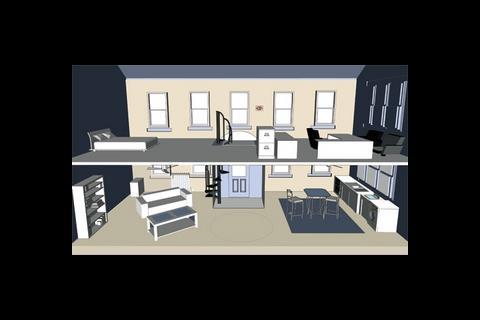What will building services be delivering three decades from now? BSj asks industry experts to predict how Britain will be living, working and shopping
Opening the windows on a hot day will become a thing of the past in homes as well as offices. Thirty years from now, new houses will have facades that can sense changing conditions and adapt their interior environment accordingly. And comfort at home will be more important than ever, as most of us will be spending more time there – working. We’ll still go to the shops though, because that will have become a much more entertaining experience.
These are some of the predictions of industry experts of how our lives and buildings will be in 2038. By then, new houses will be perfectly airtight and insulated and controlled by fuel cell technology linked to a hydrogen infrastructure that will provide power, says Ant Wilson, business unit director of Faber Maunsell’s Sustainable Development Group. ��ɫ����TV Regulations will have escalated significantly, and further legislation will dictate a marked change in the building services supplying UK dwellings.
“We will have moved on from some of the things we do today, such as the opening of windows and relying on natural ventilation,” he says. “We will be using demand-controlled air ventilation with carbon dioxide sensors, variable speed fans and even triple-glazed argon-filled windows that control and limit the transfer of heat through glass. “��ɫ����TVs will feature energy recovery, both in terms of heating and cooling. Fuel cell technology connected to a hydrogen infrastructure will generate our hot water and electricity. Solar roofs will link to the hydrogen infrastructure and will mean we could be able to generate our own energy.” he says. Fuel cell systems use an electrochemical process to convert fuel into electricity to provide power, but can also supply a thermal energy source to heat water and buildings.
Solar roofs could be a legal requirement in newbuild housing by 2038, Wilson says. “It is conceivable that ��ɫ����TV Regulations will require all new homes to have 2-3m2 of solar panels or slates. Certainly all new buildings are likely to have photovoltaic or solar thermal incorporated in the roof, and both in the case of homes.”
Wilson’s assertions are supported by legislative and economic trends. Initiatives such as the Code for Sustainable Homes and the European Energy Performance of ��ɫ����TVs Directive are driving change in the approach to designing and building homes, while the economic impact of rising energy costs is accelerating the need for solutions that go beyond the environmental argument for fresh thinking.
Taking control
Many of the issues occupying the thoughts of building services engineers today will have been solved by 2038, according to Professor Derek Clements-Croome, director of research for the School of Construction Management at Reading University. “Sustainability will be perceived as just a part of the process, rather than the big issue it is today,” he says. “We will have solved the problem of individual control in buildings. The elements that allow individuals to control their working or living environments will have been normalised by 2038.”
Individual control is an important issue on a number of levels. It has economic and environmental implications in terms of the wasteful cost of heating, lighting or powering spaces when they are not in use, as well as productivity consequences given that no two people will respond in the same way to their environment. Maximising productivity by allowing staff to control their individual working environments is likely to become increasingly important.
Clements-Croome believes that the post-occupancy-evaluation (POE) will be an important component in finding remedies for such issues. Unlike traditional market research, which is usually commissioned and filtered through outside agencies, POEs get to the heart of the issues affecting the actual users of buildings, including visitors, by liaising directly with them to understand how they interact with the building, and by learning what problems they face.
“It will become much more normal to go through POEs,” Clements-Croome says. “At the moment we tend to design, build and leave buildings, but in future we will be continually going back and evaluating them. This will enable us to solve problems faster, both in the creation of new buildings and in adapting existing ones.”
David Strong, chief executive of sustainability consultancy Inbuilt, believes that resilience will be the watchword in 2038. “��ɫ����TVs that are heavily serviced are extremely vulnerable. This will become an increasingly important issue, especially in offices, where an interruption to services can have a severe impact.”
��ɫ����TVs where power is essential, such as hospitals, already have back-up systems but Strong expects this to become common in offices to combat the threat of “economic and social dislocation”. Put another way, if offices are involuntarily deprived of services such as telephony or power, it restricts occupiers’ ability to make money or communicate.
Clients will become more demanding, and engineers will have to find solutions that prevent this scenario from occurring, especially in light of enhanced internet protocol technologies that will allow one network to control a broad selection of services ranging from information and communication technology to energy controls. Greater simultaneous control of building systems is advantageous but it strengthens the argument that buildings need to be resilient to system failures.
Retail space will need to be far more creative in the future, offering education and entertainment
Responding to nature
Strong expects a progression towards natural resources when specifying building materials. “There will be a much higher attention to detail and I can see a greater use of timber and stone to lock the carbon into the structure for the life of the building,” he says.
Price is also likely to be a big factor in the choice of materials, with glass, steel and aluminium costs “going through the roof”, according to Adrian Gray, managing director of Waterman ��ɫ����TV Services. Gray does, however, see the involvement of engineers at this stage in the development process as a positive step. “The issue of low carbon footprint design has changed the status of the building services engineer. We are becoming more involved at the concept stage, and having a major say on topics such as shading and facades.”
Clements-Croome envisages greater variation and elements of control in facades. “Advances in nanotechnology will lead to the development of materials that will be self-adapting to different situations. They will sense the prevailing conditions and change themselves. Facades will behave in a manner not totally dissimilar to human skin.”
Home/office fusion
Breakthroughs in ICT may yet render the traditional office obsolete. By 2038 office hubs in the home could be the norm, Wilson believes. “We may well be using video conferencing as standard, which begs the question of whether we will need offices at all. There could even be new types of buildings created. Residential communities could have social networking hubs to allow people to use facilities near home.”
Strong at Inbuilt also questions whether offices will be necessary in three decades, but does offer a caveat about looking ahead: “I remember years ago when people predicted the age of the paperless office. It hasn’t quite happened yet, has it? We have to ask, though, if we will even be working in offices or if everyone will be at home. IT developments will certainly make location a secondary issue.”
Individual focus
Technological advances in retail have put a greater emphasis on the individual, allowing shoppers to buy online and changing the role of the actual bricks and mortar shop. This will impact on the design and building services components of the retail store of 2038, according to Ian Standring, a director at WSP Group. “The days of retail being just about shops are already ending. The focus is shifting to ‘the experience’. Retail space will need to be far more creative and offer customer attraction, education and entertainment in the future. Appealing to families will be important.”
He believes the technologies involved mean there will be much greater emphasis on how retail space works. “Heating, cooling, lighting, storage, purchase and supply are all likely to develop and possibly change completely. Sustainability will be an increasingly important thread. Energy efficiency and recycling will be a way of life. Offsite fabrication could continue to grow in popularity and engineering solutions will need to be increasingly sophisticated.
“Given the need to reduce emissions, cater for lifestyle changes and provide a more comfortable environment to retain customers for longer, shopping patterns could shift dramatically. In Canada, there is winter shopping underground in Montreal. There could well be more of this type of development.”
Standring says that engineering for energy efficiency is particularly important in retail: “It is more difficult to cut emissions from transport than buildings – and global air travel is predicted to increase – so there will be pressure for retail developments around the world to become not only carbon neutral but carbon positive. Retail developments will be under pressure both to meet their own energy needs and offer ‘carbon credit’ to offset transport. Forward-thinking developers and retailers are already preparing the introduction of energy from district schemes and renewable sources.
“The building services industry will need to be involved in the evolution of how transport relates to retailing. Whether the links are cars, buses or trains, there will need to be some form of parking or docking as people travel back and forth and goods are transported.”
Source
��ɫ����TV Sustainable Design


























No comments yet